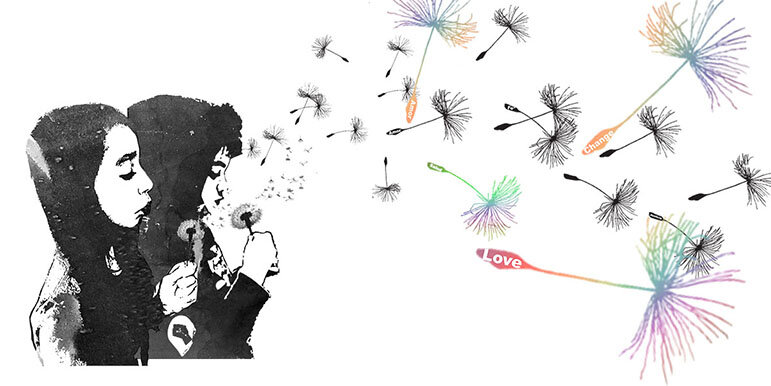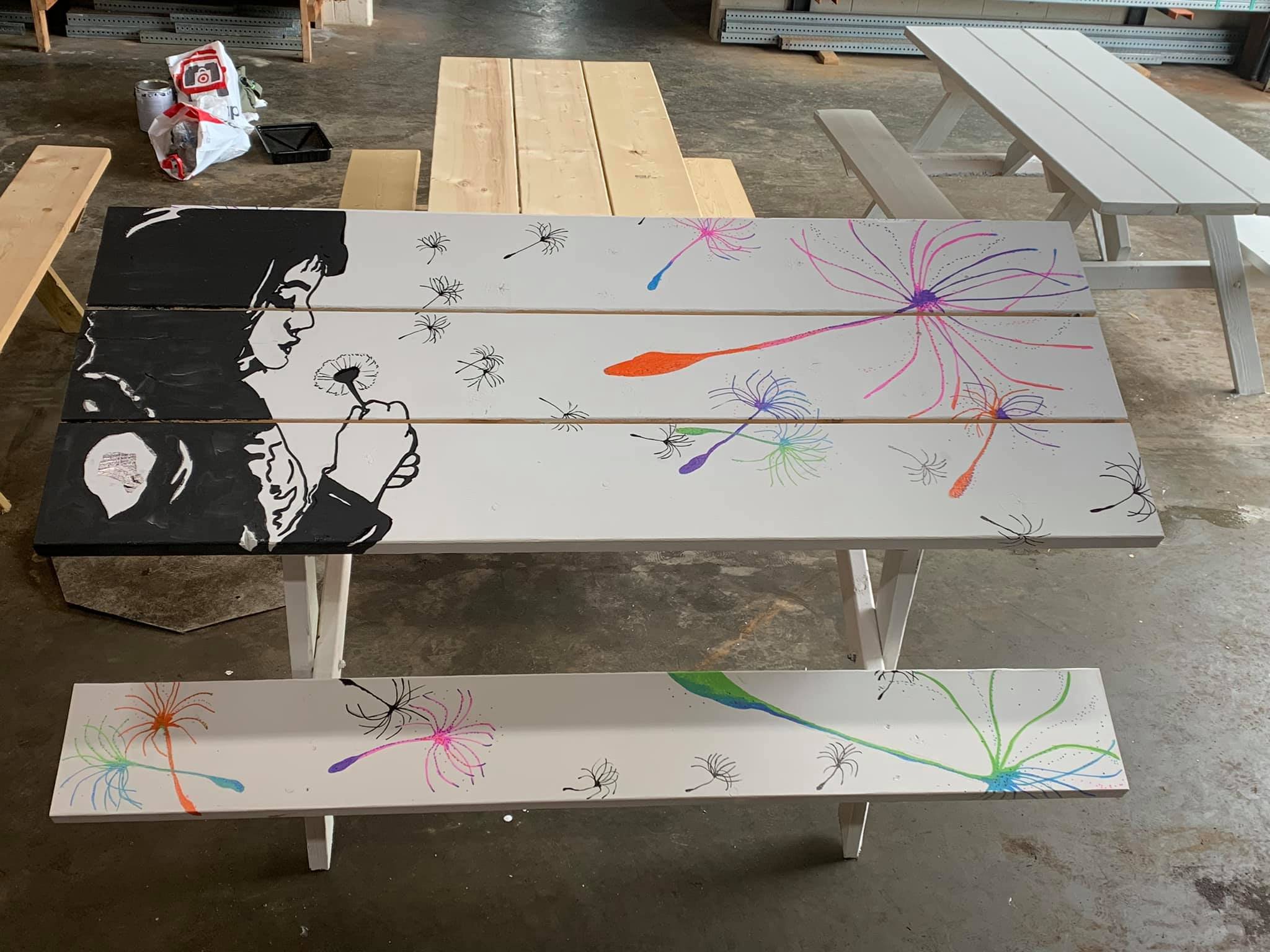Wish for Change…
Justice for George Floyd. #BlackLivesMatter. #Love #Peace. #Health #Restructuring. #visibility
Wish for Change was created in Belmont, Ma during the pandemic lock down. It has now been displayed at New Art Center, Newton, MA; Worcester State University; Umbrella Center for the Arts in Concord, MA; Public Art project in Milford, MA; painted in Belmont, MA public art project.

Part of the my process in designing Wish for Change, stemmed from my need to create a way to talk to my own child about the current events of 2020. The design is meant to spark conversation about difficult issues in our society with children in a fun and positive way.
Wishes around the world…
Flower
What does a Dandelion symbolize? In bloom it is considered a weed, a plant not welcomed or wanted in a garden. It sprouts in random places, often between cracks. It then transforms into a puff ball of seeds. The seeds migrate, carried by the wind. Where to? Never knowing where it may land or where it may be taken. What kind of wind does it face? A soft gentle breeze or a whirling gust.
Sanchez Family Wishes for Unity, Faith, & Strength
a Wish
Did you know a Dandelions contain medicinal use and it is edible? The flower and leaves ignored by many. Only its puff ball of seeds attracts the curiosity of children and adult alike. Symbol of wishes carried by the wind.
Deseo… #Paz # Amor #Libertad
Visibility
Today I use it a symbol of visibility: as many walk by the dandelion and ignore it.
Hope: as it carries its seeds to unknown destinations, migrating to a new location hopeful to give what it carries within.
Change: the flower promotes change, as it transforms from a flower into the puff of seeds where its knowledge and healing are stored in a mission to reach all.





Installations
#InResistance
The Black and White Puerto Rican flag is seen as a symbol of mourning and resistance.
It emerged from a group of artists on the island in 2016 to express a state of mourning the island has been experiencing since the US government imposed a federal control board with power over the commonwealth’s jurisdiction. Black and White resist the approval of Puerto Rico’s oversight, management, and economic stability Act; also known as PROMESA. Signed by US congress and signed into law by president Barack Obama.
This flag installation is a symbol of resistance & mourning. It cries and bleeds as the struggle in PR continues and slow recovery efforts after Hurricane Maria on September 20, 2017 made visible Puerto Rico’s Colonial Status.
This flag remembers and cries for La Ley de la Mordaza, 9 years where it was a felony to show or hold a PR flag. Blackness and tears as a symbol of the many months in darkness and suffering due to the consequences of colonialism. Included the paper towel thrown at the Puerto Rican people by the current president.







Textile installation, Al Otro Lado del Charco/On the other side of the puddle, explores the everlasting historical significance and cultural tradition of the needle work “Mundillo of Puerto Rico.” As a means to encourage and uplift mundillo artisans, I closely work with and support needle workers/ artisans living in PR and the Disapora. I am interested in connecting with the generation of needleworkers in the mainland, whom continue to celebrate their culture and heritage by teaching, producing mundillo in and outside of PR.
I have found historical documentation on the long history of Puerto Rican migration to the U.S. Mainland specifically in the textile industry.
“Puerto Rico opened new possibilities for experimentation because the 1898 Treaty of Paris did not address territorial incorporation or statehood, and the island had a tradition of women’s needlework that could be appropriated to serve U.S. textile and garment enterprises in a variety of ways. Linking the history of Puerto Rican needleworkers to the larger history of the textile and garment industry makes visible both the women and intricate mechanisms of global capitalism. The history reveals the common, accepted employment label divisions between women workers in the global textile and garment industry as social and cultural constructs that segregated workers and set them in opposition rather than connection although they performed similar work. Immigrant mill workers in the Northeast, garment workers in New York, southern mill hands, and Puerto Rican needleworkers actually labored in the same global textile and garment operation and navigated linked jobs and industry conditions throughout the twentieth century.” From Sovereignty, Citizenship, and Labor: Puerto Rican Needleworkers and a Deep History of Neoliberalism by Aimee Loiselle Graduate Conference: The Public-Private Divide American Political History Institute Boston University
Since the beginning of the 20th century migration of Puerto Rican needleworkers had been appealing for women in Puerto Rico. Operation Bootstrap in the mid-1940s was program intended to contour the related nonsequential flows by further encouraging manufacturing facilities on the island and cheap labor migration to the mainland.
Hurricane Marias’ devastation in 2017 made PR visible to the rest of the mainland. A Washington Post article from March 2018 states, “Nearly 500,000 people left Puerto Rico for the mainland during the past decade according to Pew Research center…”
Latinx Heroes in The USA, Community Art class
#InDarkness: 2 day happening, Foster Gallery at Nobles & Greenough School
Adios Puerto Ricans Always in Migration I
First banner/mural created for town of Fitchburg, MA.
Adios: Puerto Ricans always in migration aims to make visible the longing and nostalgia all migrants feel in their farewell. Valor and Sacrifice to leave loved ones behind in hopes to reach their dreams and aspirations. My digitally composed mural aims to capture the moment of departure between loved ones, not knowing when/if they will see each other again. As a Puerto Rican whom left the island as a child this image is vivid representation in my migrant story.








